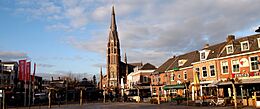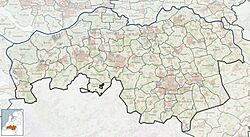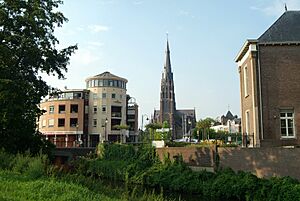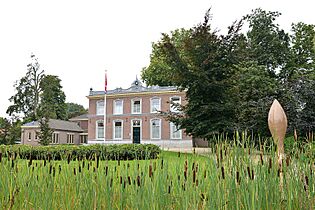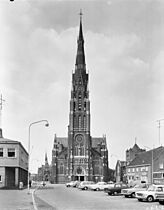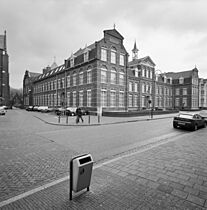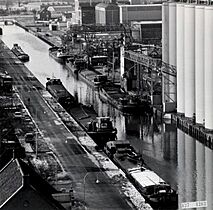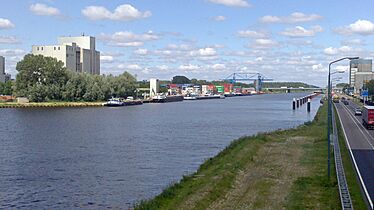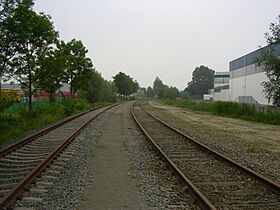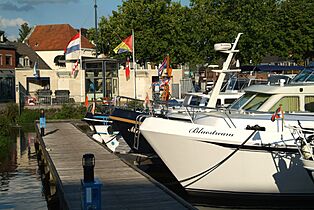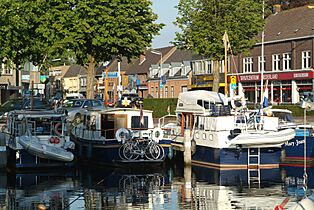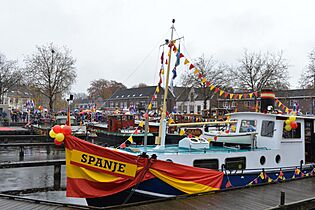Veghel facts for kids
Quick facts for kids
Veghel
|
|||
|---|---|---|---|
|
Town and former municipality
|
|||
|
From top down, left to right: market square of Veghel,
former cantonal court and town hall, Klondike villa, Sacred Heart statue, Wiebenga silo, Airborne Monument, Saint Lambert Church, former Synagogue of Veghel |
|||
|
|||
| Country | |||
| Province | |||
| Municipality | Meierijstad | ||
| Incorporated | 1310 | ||
| Market rights | 1719 | ||
| Merged | 2017 | ||
| Area | |||
| • Town | 43.06 km2 (16.63 sq mi) | ||
| Elevation | 10 m (30 ft) | ||
| Population
(2021)
|
|||
| • Town | 32,585 | ||
| • Density | 756.73/km2 (1,959.93/sq mi) | ||
| Demonym(s) | Veghelaar | ||
| Time zone | UTC+1 (CET) | ||
| • Summer (DST) | UTC+2 (CEST) | ||
| Postcode |
5460–5469
|
||
| Area code | 0413 | ||
Veghel is a town in the southern part of the Netherlands. It used to be its own municipality, but on January 1, 2017, Veghel joined with two other towns, Schijndel and Sint-Oedenrode. They formed a new, bigger municipality called Meierijstad. This new area became the largest municipality in the North Brabant province by land size.
Contents
History of Veghel
The first people settled in Veghel a very long time ago, during Roman times. They built their homes near the River Aa. The oldest written mention of Veghel is from 1225. It's a document from the Berne Abbey, written in Latin, which talks about land owned by the abbey in a place called "Vehchele."
In 1310, a ruler named John II of Brabant gave the people of Veghel the right to use shared land. For a while in the 1500s and 1600s, the town was governed by the Lords Van Erp, who lived in their castle called Frisselsteijn in Veghel.
In 1648, Veghel became part of the Dutch Republic. Because it was a Catholic town in a mostly Protestant country, Veghel faced some tough times. It was part of a special military zone.
Becoming a Market Town
In 1719, Veghel became a market town. This meant it was allowed to hold weekly markets and four big annual fairs. This was a special privilege given by the government. Later, in 1795, during the French wars, Veghel finally got full freedom of religion and equal rights from the Dutch government. In 1810, Veghel officially became part of the Kingdom of the Netherlands.
From the mid-1800s, Veghel started to grow from a farming town into an industrial one. This happened because the South Willem's Canal was opened, making it easier to transport goods. Important buildings like the large church and the town hall were built around this time. Religious groups also helped Veghel become a center for health care and education, which it still is today.
World War II and Modern Growth
In 1940, German troops took over Veghel during World War II. In 1944, during a big military operation called Operation Market Garden, Allied paratroops landed in Veghel. This was because of its important location.
Since the 1950s, Veghel has grown a lot. Many new businesses have started there, including big international companies like Mars, Incorporated and DHL Supply Chain. Veghel is also an important place for education in the area. It has several high schools and colleges.
Since 1994, Veghel and the nearby town of Erp have been part of the same municipality.
People and Cultures
Veghel is home to people from many different countries. More than 22% of the town's population comes from other parts of the world. In total, people from over a hundred different countries live in Veghel. Most of these people live in the main town area of Veghel itself.
Largest Foreign Groups (2015)
- Turks: 1,457 people
- Poles: 806 people
- Indonesians: 662 people
- Moroccans: 585 people
- Germans: 526 people
- Surinamese: 372 people
- Yugoslavs: 181 people
- Belgians: 167 people
- Portuguese: 149 people
- Somalis: 139 people
- Soviets: 121 people
- Chinese: 100 people
Fun Festivals
Veghel has some cool festivals throughout the year:
- Every November, people celebrate the arrival of Sinterklaas (Saint Nicholas).
- Every two years in June or July, the Slokdarmfestival takes place.
- On September 1st, there's a fun harbor festival.
- In February or March, the traditional Carnival is held.
Places to See
- The beautiful St Lambert Church, built in a style called neogothic. It also has a graveyard with war graves.
- The old town hall, which has a grand neorenaissance style.
- The old synagogue, which has been rebuilt.
- The Protestant church.
- The monastery of the Franciscan Sisters. It has lovely gardens and its own church.
Famous People from Veghel
Many talented people have come from Veghel:
- Anky van Grunsven: A world-famous dressage champion (horse riding).
- Dillianne van den Boogaard: A former player for the Netherlands women's national field hockey team.
- Earnie Stewart: A former soccer player for the United States men's national soccer team.
- Theo Lucius: A professional footballer who played for big teams like PSV Eindhoven.
- Theo Maassen: A well-known comedian and actor.
- Glenn van Berlo: A racing driver.
Sister Cities
Veghel has special friendships with two other towns in different countries:
Images for kids
-
Villa Klondike, former headquarters of the 501st Parachute Infantry Regiment (101st Airborne Division)
-
Statue of the Sacred Heart of Jesus at the marina square
-
Modernist silo by J.G. Wiebenga, part of the New Objectivity movement
-
Marina of Veghel during the entry parade of Sinterklaas, 16 November 2014


